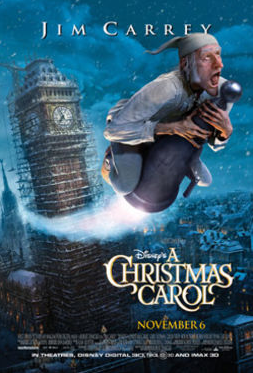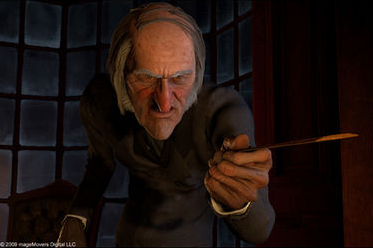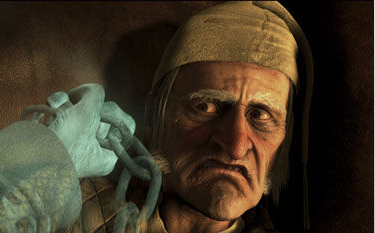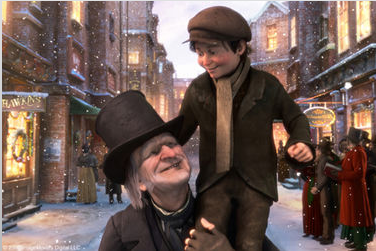A Christmas Carol

 Watching the film through the glasses was like watching it through a dirty window. I was left with the constant desire to spray Windex up on the screen. The colors are so muted and sometimes muddy looking, it almost ruins the experience. I found myself constantly slipping the glasses off to see if there was a difference. There was a drastic difference. Without the glasses, everything was fuzzy and out of focus, but the colors were much more vibrant. It made me wish I was watching the thing in good old fashioned 2D, so I could enjoy both picture quality and vibrant color. I know that it's only one film, and it may not be the best example of the technology, as I have nothing to compare it to. But, this was enough to convince me that 3D still has a long way to go before it is the end-all format, and the definitive way to watch film in the theater.
Watching the film through the glasses was like watching it through a dirty window. I was left with the constant desire to spray Windex up on the screen. The colors are so muted and sometimes muddy looking, it almost ruins the experience. I found myself constantly slipping the glasses off to see if there was a difference. There was a drastic difference. Without the glasses, everything was fuzzy and out of focus, but the colors were much more vibrant. It made me wish I was watching the thing in good old fashioned 2D, so I could enjoy both picture quality and vibrant color. I know that it's only one film, and it may not be the best example of the technology, as I have nothing to compare it to. But, this was enough to convince me that 3D still has a long way to go before it is the end-all format, and the definitive way to watch film in the theater. So, what of the film itself? Writer-director Robert Zemeckis (Beowulf) has more or less given us the story everyone knows, only wrapped up in a shiny wrapper of performance capture CG animation. It's a process he's employed in his previous two films, and this is easily his best use of it. The characters have more emotion and life to them, which has been a problem that has plagued his past efforts. His first attempt at using the technology, back in 2004's Polar Express, gave us characters that were detailed, but had dead eyes or stiff faces. This time around, while the technology still has a ways to go (some of the minor or background characters look like robotic video game avatars), we get much more vibrant and life-like movements, and the eyes of the characters are better detailed, though there are still some issues. I was initially worried when I heard that Zemeckis was using this technology to tell Dickens' classic tale of redemption, since so much of the story relies on emotion, and I feared the characters would be too stiff to deliver the proper feeling. But, we get mostly the right tone here. Not just from Scrooge (whose performance is provided by Jim Carrey), but from many of the main supporting cast.
So, what of the film itself? Writer-director Robert Zemeckis (Beowulf) has more or less given us the story everyone knows, only wrapped up in a shiny wrapper of performance capture CG animation. It's a process he's employed in his previous two films, and this is easily his best use of it. The characters have more emotion and life to them, which has been a problem that has plagued his past efforts. His first attempt at using the technology, back in 2004's Polar Express, gave us characters that were detailed, but had dead eyes or stiff faces. This time around, while the technology still has a ways to go (some of the minor or background characters look like robotic video game avatars), we get much more vibrant and life-like movements, and the eyes of the characters are better detailed, though there are still some issues. I was initially worried when I heard that Zemeckis was using this technology to tell Dickens' classic tale of redemption, since so much of the story relies on emotion, and I feared the characters would be too stiff to deliver the proper feeling. But, we get mostly the right tone here. Not just from Scrooge (whose performance is provided by Jim Carrey), but from many of the main supporting cast. Look at the scene where Scrooge is visited by the ghost of his dead business partner, Jacob Marley (Gary Oldman) early on to see just how far the technology has gone. We sense genuine fear in Scrooge, and for very good reason. Zemeckis makes total use of the freedom of animation, and turns Jacob into a much more frightening specter than he has been in almost any recent filmed adaptation of the story you can think of. His jaw dislocates in a ghoulish and surprisingly graphic fashion, and there is so much malice in Oldman's line delivery. He could make anyone believe they are about to be visited by spirits later that night. The job of any animated film is to make us forget that what we are watching is not real, and become lost in the story it's trying to tell. While I never mistook the characters for not being CG creations, the filmmakers have managed to give the characters a certain life of their own. Some of the creations somewhat resemble the actors portraying them (Scrooge does have some of Carrey's features, only withered), while others we recognize by their voice. Both Carrey and Oldman portray multiple characters in the film. Oldman also plays Scrooge's put-upon employee, Bob Cratchit, while Carrey portrays the three spirits that visit Scrooge during the night. Other actors handling multiple minor roles include Bob Hoskins, Robin Wright-Penn, Colin Firth, and Cary Elwes.
Look at the scene where Scrooge is visited by the ghost of his dead business partner, Jacob Marley (Gary Oldman) early on to see just how far the technology has gone. We sense genuine fear in Scrooge, and for very good reason. Zemeckis makes total use of the freedom of animation, and turns Jacob into a much more frightening specter than he has been in almost any recent filmed adaptation of the story you can think of. His jaw dislocates in a ghoulish and surprisingly graphic fashion, and there is so much malice in Oldman's line delivery. He could make anyone believe they are about to be visited by spirits later that night. The job of any animated film is to make us forget that what we are watching is not real, and become lost in the story it's trying to tell. While I never mistook the characters for not being CG creations, the filmmakers have managed to give the characters a certain life of their own. Some of the creations somewhat resemble the actors portraying them (Scrooge does have some of Carrey's features, only withered), while others we recognize by their voice. Both Carrey and Oldman portray multiple characters in the film. Oldman also plays Scrooge's put-upon employee, Bob Cratchit, while Carrey portrays the three spirits that visit Scrooge during the night. Other actors handling multiple minor roles include Bob Hoskins, Robin Wright-Penn, Colin Firth, and Cary Elwes. For all of its technology, the most admirable aspect of A Christmas Carol is how closely the film sticks to the source material. In fact, it is during the rare moments that the film goes off on its own that it spirals into wrong-headedness. There's an extended sequence where the Ghost of Christmas Yet-to-Come shrinks Scrooge to the size of a mouse (complete with an Alvin and the Chipmunks-like voice), and sends him on a pointless action sequence where the tiny Scrooge must run through the sewers and streets of London in his shrunken state, all the while pursued by the Ghost in a phantom horse and carriage. This sequence seems more at home in a video game, and indeed, after my screening got out, I saw a video game tie-in for the film sitting on the shelf of a Toys R Us nearby the theater. How does one make a video game off of the story, I have no idea, but the whole sequence smells of studio interference. There are other action-heavy sequences that seem out of place, but they don't come as often as the film's ad campaign would like to have you believe. For the most part, the movie reminds us that hey, Dickens' story was actually kind of dark and creepy.
For all of its technology, the most admirable aspect of A Christmas Carol is how closely the film sticks to the source material. In fact, it is during the rare moments that the film goes off on its own that it spirals into wrong-headedness. There's an extended sequence where the Ghost of Christmas Yet-to-Come shrinks Scrooge to the size of a mouse (complete with an Alvin and the Chipmunks-like voice), and sends him on a pointless action sequence where the tiny Scrooge must run through the sewers and streets of London in his shrunken state, all the while pursued by the Ghost in a phantom horse and carriage. This sequence seems more at home in a video game, and indeed, after my screening got out, I saw a video game tie-in for the film sitting on the shelf of a Toys R Us nearby the theater. How does one make a video game off of the story, I have no idea, but the whole sequence smells of studio interference. There are other action-heavy sequences that seem out of place, but they don't come as often as the film's ad campaign would like to have you believe. For the most part, the movie reminds us that hey, Dickens' story was actually kind of dark and creepy. Let this be a warning to parents to heed the film's PG-rating, and to think twice about taking young children to see it. This is one of the harder PG films I've seen in a while, and joins the likes of recent family films like Where the Wild Things Are and Coraline that may be too intense for very small kids. Aside from the previously mentioned Jacob Marley sequence, there is also the rather disturbing way that the Ghost of Christmas Present makes his exit. In most film versions, his hair turns gray as he nears his departure, and he simply fades away into nothingness to make way for the next Ghost. Here, the spirit not only turns gray and withered, but also seems to suffer a massive heart attack as he makes his exit. He laughs almost maniacally as he collapses in pain, his flesh slowly melting off his body, revealing a massive cackling skeleton that eventually also fades away into dust. This is all after the Ghost presents a pair of scary, demonic children (representing "want" and "ignorance") to Scrooge. Another minor sequence involves Scrooge witnessing various tortured spirits wandering the streets of London, including one sobbing over the fate of his own homeless wife and child, and how he cannot help them.
Let this be a warning to parents to heed the film's PG-rating, and to think twice about taking young children to see it. This is one of the harder PG films I've seen in a while, and joins the likes of recent family films like Where the Wild Things Are and Coraline that may be too intense for very small kids. Aside from the previously mentioned Jacob Marley sequence, there is also the rather disturbing way that the Ghost of Christmas Present makes his exit. In most film versions, his hair turns gray as he nears his departure, and he simply fades away into nothingness to make way for the next Ghost. Here, the spirit not only turns gray and withered, but also seems to suffer a massive heart attack as he makes his exit. He laughs almost maniacally as he collapses in pain, his flesh slowly melting off his body, revealing a massive cackling skeleton that eventually also fades away into dust. This is all after the Ghost presents a pair of scary, demonic children (representing "want" and "ignorance") to Scrooge. Another minor sequence involves Scrooge witnessing various tortured spirits wandering the streets of London, including one sobbing over the fate of his own homeless wife and child, and how he cannot help them.
See the movie times in your area or buy the DVD at Amazon.com!






0 Comments:
Post a Comment
<< Home